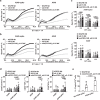Off-the-shelf CAR natural killer cells secreting IL-15 target spike in treating COVID-19
- PMID: 35546150
- PMCID: PMC9095674
- DOI: 10.1038/s41467-022-30216-8
Off-the-shelf CAR natural killer cells secreting IL-15 target spike in treating COVID-19
Abstract
Engineered natural killer (NK) cells represent a promising option for immune therapy option due to their immediate availability in allogeneic settings. Severe acute diseases, such as COVID-19, require targeted and immediate intervention. Here we show engineering of NK cells to express (1) soluble interleukin-15 (sIL15) for enhancing their survival and (2) a chimeric antigen receptor (CAR) consisting of an extracellular domain of ACE2, targeting the spike protein of SARS-CoV-2. These CAR NK cells (mACE2-CAR_sIL15 NK cells) bind to VSV-SARS-CoV-2 chimeric viral particles as well as the recombinant SARS-CoV-2 spike protein subunit S1 leading to enhanced NK cell production of TNF-α and IFN-γ and increased in vitro and in vivo cytotoxicity against cells expressing the spike protein. Administration of mACE2-CAR_sIL15 NK cells maintains body weight, reduces viral load, and prolongs survival of transgenic mice expressing human ACE2 upon infection with live SARS-CoV-2. These experiments, and the capacity of mACE2-CAR_sIL15 NK cells to retain their activity following cryopreservation, demonstrate their potential as an allogeneic off-the-shelf therapy for COVID-19 patients who are faced with limited treatment options.
© 2022. The Author(s).
Conflict of interest statement
Drs. Caligiuri and Yu are co-founders of CytoImmune Therapeutics, Inc. The remaining authors have no conflicts of interest to disclose.
Figures





References
-
- Organization WHO. Coronovirus disease (COVID-19) pandemic. (2022).
Publication types
MeSH terms
Substances
Grants and funding
LinkOut - more resources
Full Text Sources
Other Literature Sources
Medical
Molecular Biology Databases
Miscellaneous

